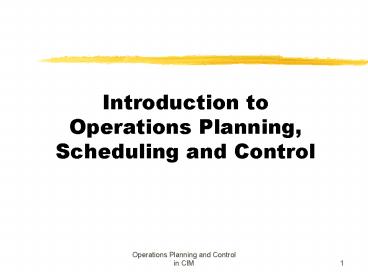Introduction to Operations Planning, Scheduling and Control - PowerPoint PPT Presentation
1 / 24
Title:
Introduction to Operations Planning, Scheduling and Control
Description:
Sheet Metal (8 in2) Product Structure Tree. Board (1) Pressboard (1) ... planned order receipts offset by lead time. Operations Planning and Control in CIM ... – PowerPoint PPT presentation
Number of Views:397
Avg rating:3.0/5.0
Title: Introduction to Operations Planning, Scheduling and Control
1
Introduction to Operations Planning, Scheduling
and Control
2
Operating systems service supply manufacturing M
anufacturing planning and control (MPC) based on
time frames Strategic plans - over a
year Aggregate plan - 2 - 18 months Disaggregate
plan - shortest time frame dealing with
production issues major part of MPC is the last
two
3
- Aggregate planning
- efficient production plan
- effects of output rates, inventory levels and
back orders affect enterprise resources - products of similar designs are combined into
groups for planning purposes
4
- Disaggregate planning
- products separated into parts and plans based on
these parts for purposes of production - first step is to create a Master production
schedule (MPS) from the aggregate plan - braking down production quantities from the
aggregate plan into item by item production in
the given period of the aggregate plan - A Materials Requirements planning (MRP)
translates the MPS into a detailed schedules for
RM and parts (usually done by computer)
5
- Disaggregate planning(cont.)
- Capacity planning - determining the labor and
equipment resources required to achieve the MPS - Components of a MPS -
- customer orders
- forecasted demand
- spare parts needed
6
- MRP
- Inputs
- Bills of Material
- Inventory Data
- Planning Factors
- Outputs to Material Requirements Planning
- Schedule of planned production order releases
- Schedule of planned purchase order releases
- Action notice
- Computerized inventory control production
planning system - Schedules component items when they are needed -
no earlier and no later
7
MRP Inputs Outputs
Master Production Schedule
Planned Order Releases
Work Orders
Purchase Orders
Rescheduling Notices
8
- Applications
- Dependent and discrete items
- Complex products
- Job shop production
- Assemble-to-order environments
Ch 13 - 3
9
Master Production Schedule
- Drives MRP process with a schedule of finished
products - Quantities represent required production not
demand - Quantities may consist of a combination of
customer orders demand forecasts
Ch 13 - 6
10
Product Structure Tree
Clipboard
Level 0
Rivet (2)
Clip Assembly (10)
Level 1
Spring (1)
Bottom Clip (1)
Top Clip (1)
Pivot (1)
Level 2
Iron Rod (3 in.)
Spring Steel (10 in.)
Sheet Metal (8 in2)
Sheet Metal (8 in2)
Level 3
Ch 13 - 8
11
The MRP Matrix
- Item
- name or number identifying scheduled item
- LLC
- low-level-code lowest level at which item
appears in a product structure
12
Parts Of MRP Matrix
- Lot size
- order multiples of this qty can be min/max qty
- LT (lead time)
- time from order placement to receipt
- PD (past-due)
- orders behind schedule
- Gross requirements
- demand for item by time period
13
- Scheduled receipts
- quantity already on order receipt date
- released orders become scheduled receipts
- Projected on hand
- expected on-hand inventory at end of period
- Net requirements
- net amount needed after on-hand adjustments
- Planned order receipts
- net requirements adjusted for lot-sizing
- Planned order releases
- planned order receipts offset by lead time
14
Capacity Requirements Planning (CRP)
- Computerized system that projects load from
material plan - Creates load profile
- Identifies underloads and overloads
15
Capacity Terms
- Load profile
- compares released and planned orders with work
center capacity - Capacity
- productive capability includes utilization and
efficiency - Utilization
- of available working time spent working
16
More Capacity Terms
- Efficiency
- Load
- the standard hours of work assigned to a facility
- Load percent
- the ratio of load to capacity
17
Capacity Requirements Planning
MRP planned order releases
Open orders file
Capacity requirements planning
Routing file
Load profile for each machine center
18
Remedies for Underloads
- 1. Acquire more work
- 2. Pull work ahead that is scheduled for later
time periods - 3. Reduce normal capacity
19
Remedies for Overloads
- 1. Eliminate unnecessary requirements
- 2. Reroute jobs to alternative machines or work
centers - 3. Split lots between two or more machines
- 4. Increase normal capacity
- 5. Subcontract
- 6. Increase the efficiency of the operation
- 7. Push work back to later time periods
- 8. Revise master schedule
20
Manufacturing Resource Planning (MRP II)
- Extension of MRP
- Plans all resources needed for running a business
- Variations include
- Service Requirements Planning (SRP)
- Business Requirements Planning (BRP)
- Distribution Requirements Planning (DRP)
21
MRP II Modules
- Forecasting
- Customer order entry
- Production planning / master production
scheduling - Product structure / bill-of-material processor
- Inventory control
- Material requirements planning
- Capacity planning
- Shop floor control
- Purchasing
- Accounting
- Financial analysis
22
Advanced Planning Control Systems
- Enterprise Resource Planning (ERP)
- updates MRP II with relational DBMS, GUI
client/server architecture - Manufacturing Execution Systems (MES)
- links business planning mgmt control systems
- Customer-Oriented Manufacturing Management
Systems (COMMS) - unites departments suppliers around customer
- multi-plant planning, multiple languages
currencies
23
Problems with MRP
- Material requirements plan is first capacity is
an afterthought - MRP assumes fixed lead times
- Excessive reporting requirements
24
Prospects for MRP/MRP II
- Coordinates company strategy among different
functional areas - Responds quickly to what-if? questions at various
levels of detail - BOM processors, purchase modules, customer
order entry are standard requirements for
Manufacturing Information Systems - Monitors design vendor quality, customer
service - Builds trust, teamwork, better decisions
- Cash-flow planning profit/cost projections

